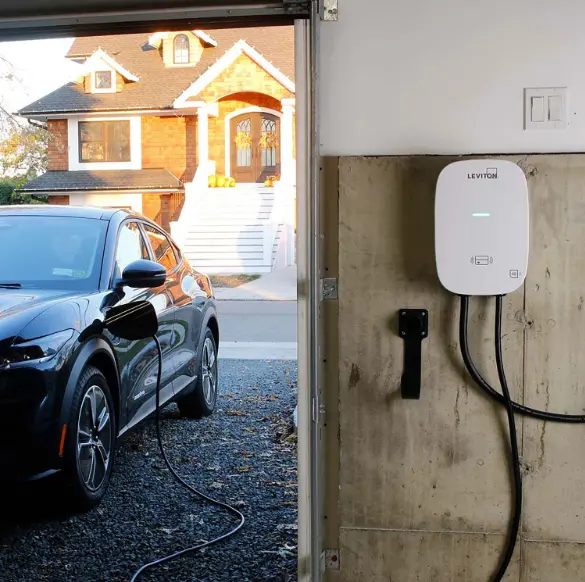
As concerns over climate change and carbon emissions intensify, the world is witnessing a paradigm shift in the automotive sector. Electric vehicles (EVs), once considered a distant future, are rapidly becoming a staple on our roads. Their rise, propelled by advancements in technology, regulatory support, and increasing consumer awareness, represents a significant move towards sustainable transportation. With this growing adoption of EVs, understanding EV charging has become vital. Unlike conventional cars that require a simple stop at the gas station, EVs need specific charging infrastructure. The knowledge about EV charging—from what types of EV chargers exist to how long charging takes—can help EV owners optimize their vehicle use and alleviate “range anxiety.”

Understanding electric vehicle charging
Electric Vehicle (EV) charging is the process by which an electric vehicle’s battery pack is replenished, enabling it to store and then use this energy for its operation. This process involves connecting your EV to a charger, which is in turn linked to the electrical grid. It’s akin to charging your smartphone or laptop; you plug it in, wait for the battery to fill up, and then use the device. However, unlike these smaller devices, an EV’s battery capacity is vastly larger, and as a result, charging times are significantly longer.
The role of EV charging in the usability of electric vehicles
The significance of EV charging extends far beyond merely powering the car’s movement. It plays a crucial role in the overall usability and convenience of owning and operating an EV. A crucial concept here is range: the distance an EV can travel on a single charge. This range is directly influenced by the charging process. Therefore, the quicker and more available the charging process, the further and more flexibly the vehicle can be used.
Understanding charging also becomes critical to mitigate range anxiety, which is the fear that the EV will run out of charge before reaching a charging station. EV owners can better plan their travels and alleviate such concerns by understanding how EV charging works, where charging stations are located, and how long the charging process takes.
Different types of charging: AC (slow/fast) and DC (rapid)
Broadly, EV charging can be categorized into AC (Alternating Current) and DC (Direct Current) charging. AC charging is the most common type of charging, suitable for home and workplace chargers. This involves using the AC power from your home or workplace grid, which the onboard charger of the vehicle then converts into DC power to charge the battery. Depending on the power output, AC charging can be slow or fast.

Slow AC charging is typically carried out using a standard plug socket and can take several hours to fully charge an EV. This is often done overnight at home. Fast AC charging, on the other hand, uses a specialized charging unit with a higher power output, reducing the charging time.
DC charging, also known as rapid charging, provides a significantly quicker charging solution. Unlike AC charging, DC chargers convert the power before it reaches the vehicle, allowing it to be fed directly to the battery. This process substantially reduces charging time, making it possible to achieve an 80% charge in just 20-30 minutes. DC charging stations are commonly located at highway rest stops and public charging points, facilitating long-distance travel.
Factors affecting EV charging time
You are likely aware of factors, like the type of charger used and temperature, that affect the charging of your mobile devices and laptop. Similarly, there are several factors that affect the time needed to recharge an EV vehicle’s batteries. Here are the most common.
Battery size and its impact on charging time
The size of an EV’s battery pack has a direct impact on the time it takes to fully charge the vehicle. Similar to how a larger water tank takes longer to fill, a larger battery takes longer to charge. EV batteries are measured in kilowatt-hours (kWh), with larger models often having capacities of 75 kWh or more. Therefore, while a larger battery can provide a greater driving range, it also requires a longer charging time, especially when using lower power (Level 1 or Level 2) chargers.
The power output of the charging station
The charging station’s power output, measured in kilowatts (kW), is another crucial factor influencing the EV charging time. The higher the power output, the faster an EV will charge. For instance, a Level 1 charger, with a power output of around 1.5 kW, will charge an EV relatively slowly. In contrast, a DC fast charger, offering power outputs of up to 150 kW or more, can recharge an EV significantly faster.
The type of EV charger (Level 1, Level 2, and DC Fast Charging)
The type of EV charger also plays a significant role in determining charging times. Level 1 chargers use standard household power and are the slowest, typically taking many hours to fully charge an EV. Level 2 chargers, which use a higher voltage supply (often from a dedicated circuit), can charge an EV in a few hours. DC Fast Chargers represent the fastest charging option and can replenish an EV’s battery to 80% in as little as 20 minutes. However, availability and costs can be limiting factors for Level 2 and DC Fast Chargers.
The EV model and its acceptance rate of charge
Every EV model has a specific acceptance rate of charge, which means they can only handle a certain amount of power during the charging process. This rate is mainly influenced by the vehicle’s onboard charger. For instance, if a car has an onboard charger with a maximum rate of 7 kW, it will not charge faster even when plugged into a charger with a higher power output. This makes the vehicle’s acceptance rate a critical factor in its overall charging speed.
State of the battery (nearly empty vs. nearly full)
The state of the EV’s battery at the start of charging can affect the speed at which it charges. Most EVs use lithium-ion batteries, which charge fastest when they’re almost empty and slow down as they become more full. This process, often referred to as the ‘charging curve,’ is designed to protect the battery from damage. Typically, charging speeds are fastest up to around 80% of the battery’s capacity, after which the charging speed drops significantly. Therefore, for the fastest charge, it’s often best to start charging when the battery level is low and stop at around 80% if time is a concern.
Common EV charging systems and their charging times
Level 1 Charging (standard outlet)

Level 1 charging is the most basic form of EV charging and can be done using a standard household electrical outlet of 120 volts (in the U.S). This type of charging doesn’t require any specialized equipment beyond an EVSE (Electric Vehicle Supply Equipment) cable, which is typically provided with the vehicle. Level 1 charging is relatively slow, delivering about 2-5 miles of range per hour. For instance, a Nissan Leaf with a 40 kWh battery could take upwards of 20 hours to fully charge from empty using Level 1 charging. Despite its slow pace, Level 1 charging’s advantage lies in its ubiquity and convenience – essentially any accessible power outlet can be used.
Level 2 Charging (home and public charging stations)
Level 2 charging operates at a higher voltage, usually 240 volts, and therefore charges an EV much faster than Level 1 charging. This type of charging requires a specially installed charging station and can deliver 10-60 miles of range per hour. Charging times vary depending on the power output of the specific Level 2 charger and the EV’s acceptance rate. For instance, a Tesla Model 3 Long Range with a 75 kWh battery could take about 4-6 hours to fully charge from empty using a higher-end Level 2 charger. Level 2 chargers are common in residential, workplace, and public charging settings, providing a good balance of speed and accessibility.
DC Fast Charging (superchargers)
DC Fast Charging, also referred to as Level 3 or Supercharging, provides the quickest charging option. This charging method can provide up to 100 miles of range in as little as 20 minutes under optimal conditions. However, DC Fast Charging requires specialized, high-powered charging equipment and a compatible vehicle. Not all EVs can handle the large power output of DC Fast Chargers. It’s also worth noting that frequent use of DC Fast Charging can impact the long-term health of the battery due to the heat generated during the process. Despite these caveats, DC Fast Charging is incredibly useful for long trips, reducing charging time significantly compared to Level 1 or 2 chargers.
Comparison of charging times among these systems

When comparing these systems, it’s clear that Level 1 charging is the slowest, but it also requires the least amount of setup and can be done practically anywhere with a power outlet. Level 2 charging provides a significant speed increase, making it practical for daily use, although it requires a dedicated EV charger and installation. DC Fast Charging is the quickest method, offering rapid, high-power charging, but it’s more expensive, less widely available, and not all EVs are compatible. Each system has its role, and the best one for a given situation depends on the EV’s battery status, the length of stay at a location, and the availability of charging infrastructure.
Navigating the landscape of electric vehicles and their charging infrastructure can seem overwhelming at first. However, understanding the fundamental elements of EV charging, from the various factors that influence charging times to the different types of charging systems available, empowers you to make informed decisions and optimize your EV experience. As the future of EV charging technology continues to evolve, with developments like wireless and solar charging, it’s an exciting time to be an EV owner or potential buyer. Whether you’re planning long trips or daily commutes, fast charging or overnight top-ups, remember there is a solution for every scenario. So, take your time, assess your driving habits, and find the perfect EV charger for your needs. Embrace the shift towards sustainable transportation and enjoy the journey!
This article was drafted using AI technology and then reviewed, fact-checked, and revised by a member of our editorial team.




